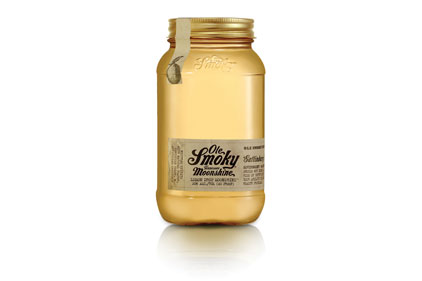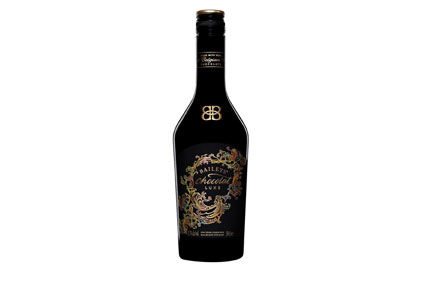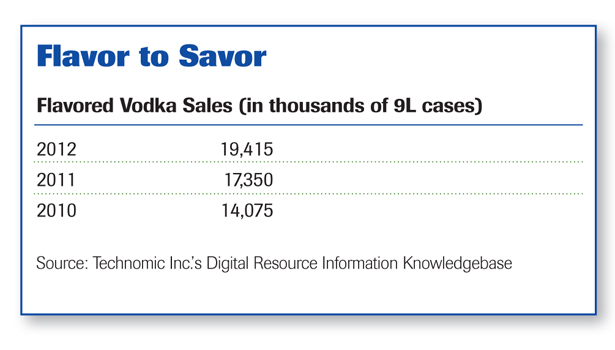
|
|
Once largely associated with illegal practices, moonshine has begun to come into its own as a distilled spirit. Old Smoky Tennessee Moonshine, for instance, has an entirely legal, fruit-flavored line of alcohol in jars. |
Consumer interest in sweeter flavors continues to grow, and alcoholic beverage makers are adjusting their offerings to meet those expectations. In fact, Liberum Capital notes the U.S. has seen a candy- and confectionery-flavored vodka boom, with flavored varieties of the drinks accounting for more than a fifth of the consumption of vodka. Considering vodka accounts for a third of all spirits sold in the U.S., this is no small market.
It is, however, a trending one. Technomic finds 52% of consumers surveyed (1,000 respondents over the age of 21) order a mixed drink with vodka away from home at least once a month. The market researcher’s online Digital Resource Information Knowledgebase (DRINK) database finds flavored vodka accounts for nearly 30% of total vodka volume—a market share that continues to grow.
As Donna Hood Crecca, senior director at Technomic, notes, “Flavored vodka is a fast-growth spirits segment, and there are plenty of seasonal offerings coming to market that can inspire bartenders or at-home mixologists this fall.”
The fall season saw caramel, apple, cinnamon, cranberry and pumpkin flavors surge to the top of the vodka flavor trends—not a huge surprise considering those are flavors traditionally associated with the season, even if perhaps not necessarily in alcoholic beverages. In terms of flavors more common to these beverages, Technomic’s DRINK database notes the leading vodka flavors are raspberry, citrus, whipped cream, orange and cherry. This certainly suggests consumers are seeking sweeter choices in their alcoholic drinks, and manufacturers are striving to oblige.
Vodka Vibes
The sheer number of sweet-flavored vodkas introduced in recent years is almost overwhelming: Beam Inc.’s Effen Vodka added a Salted Caramel Vodka; Phillips Distilling Co. introduced a candy bar-flavored vodka; Svedka Vodka has Svedka Orange Cream Pop and Svedka Strawberry Colada vodkas—as manufacturers have turned to a host of flavors to separate their vodka from the pack. For that matter, the surge in vodka flavors is not limited to sweet: chili peppers, bacon, smoked salmon and even rose have all accentuated the libation.
Nevertheless, it is the sweeter flavors that seem to stand out from the crowded marketplace. In addition to the Effen expansion, Beam also added five new flavored vodkas for fall and winter under its Pinnacle brand. Caramel Apple, Peachberry Cobbler, Pecan Pie, Salted Caramel and the limited-edition Peppermint Bark joined the 30 flavored vodkas in the brand’s portfolio.
“Pinnacle Vodka is dedicated to developing unique, indulgent flavors that create an element of fun and nostalgia for our adult consumers,” explains Jason Dolenga, senior brand director of vodka for Beam Inc., “offering an innovative twist on classic fall and winter desserts” with the most recent launches.
Indeed, the Pinnacle brand has an array of flavored vodkas, including Cookie Dough and Whipped Cream, which emerged in 2010.
“At the time, the vodka category was crowded, and many of the flavors available were more mainstream and fruity,” says Marguerite Allolding, the marketing director at White Rock Distilleries, Pinnacle’s owner at the time. “We saw a huge trend starting in the non-alcohol category with desserts and sweet treats and thought it would be interesting to see if this trend could succeed in the vodka category. Interestingly enough, it has, and we inspired many other vodka brands to explore desserts, candies, etc., for their vodkas.”
Jason Dolenga, senior director of vodka with Beam Inc., comments about the launch of Effen Salted Caramel Vodka: “When deciding to expand the Effen Vodka portfolio, we wanted to ensure that our next innovation complemented the brand’s existing unique and modern flavors. Consumers are looking for sweet and savory flavor profiles.”
The Salted Caramel Vodka promises a delicate combination of sweet and savory: sweetness enhanced with a touch of salt. It joins a line which includes Cucumber Vodka, Black Cherry Vodka and Raspberry Vodka.
Unwanted Attention
The surge of these sweeter flavors in vodkas and other alcoholic beverages has begun to draw the attention of public health officials, who contend these varieties are “designed for ‘entry-level’ drinkers;” and “are popular with underage drinkers, particularly teenage girls, and that the industry uses marketing practices that appear to target youth.”
While this is not a new phenomenon—indeed, the quotes in the previous sentence are from a 2005 edition of the Journal of Public Health Policy (volume 6, issue number 3)—it is an opinion firmly rooted in the minds of many.

|
|
With flavored vodka accounting for nearly 30% of total vodka volume, manufacturers strive to find the next flavor with mass appeal. |
However, just how true is that fairly widespread assumption? In a 2013 report published online in Alcoholism: Clinical & Experimental Research, researchers at the School of Public Health published the results of the first national study to identify the specific alcohol brands most often consumed by underage youth. Of the nearly 900 brands cited by the study participants, the top 25 accounted for nearly half of all underage consumption.
Leading the list was a beer, Bud Light, with nearly 30% of underage youths reporting they had consumed the beverage within the past 30 days; followed by 17% citing Smirnoff malt beverages; and roughly 15% saying they had recently consumed a Budweiser. Of the top 25, nine were beers; however, 12 were spirits (including four flavored vodkas), and four were flavored alcohol beverages.
In fact, the researchers noted what they termed a “surprising finding” in the study: “Several brands of flavored alcohol—among them Smirnoff’s malt and Mike’s—were very popular with younger drinkers, yet not similarly favored by adults.”
What has compelled that disproportionate popularity? The researchers contend “one of the potential reasons is marketing.”
Bear in mind, such research is similar to earlier studies into smoking years ago—efforts which managed to identify certain companies as specifically trying to target young smokers—and the young to begin smoking. The alcohol researchers believe their report may similarly inform policy efforts to reduce underage drinking.
Of course, manufacturers of alcoholic beverages will argue they do not market directly to young people, and, while that may well be true, there is the potential backlash to consider in incorporating flavors that may appeal to younger people in beverages expressly for adults.
Take a launch in Japan, for example. Admittedly, Hello Kitty is a brand whose appeal has managed to cross demographics; initially aimed at pre-adolescent females, its market has broadened to include adult consumers, to the point that the brand can be found on fashion accessories and high-end consumer products. However, now the brand and its mascot can be found on a line of fruit-flavored beers in Taiwan and China. The Taiwan Tsing Beer Co. beverage can be found with such flavors as banana, peach, lemon-lime and passion fruit. Developers are quick to note that, at 40 years old in 2014, Hello Kitty is a brand that many adult consumers have known all their lives, and the product with 2.3-2.8% alcohol by volume (ABV) is not marketed to children, not to mention the fact that there are no plans yet to bring the beverage to the U.S.
Nevertheless, there is a precedent for the brand on an adult beverage in the U.S.: Innovation Spirits introduced a line of Hello Kitty wines in 2010. However, the kid-friendly labeling of the Taiwanese beer—coupled with a range of flavors that leave reviewers concluding, “One can barely tell they’re drinking beer”—could compel policymakers to turn their attention to the flavors and marketing efforts of all adult beverages, should the beverage venture stateside. Granted, those efforts may well take place, regardless of Hello Kitty.
Such a policy effort already compelled a number of manufacturers to adjust their offerings of caffeinated alcohol beverages. A group of U.S. attorneys general investigated companies offering such beverages, contending these were being marketed to a teenage audience and that these beverages could mask feelings of intoxication.
The move prompted a number of manufacturers to reformulate their offerings, Anheuser-Busch’s Tilt and Bud Extra and MillerCoors’ Sparks among them, before a 2010 FDA warning letter to four manufacturers (Charge Beverages, New Century Brewing, Phusion Projects and United Brands Co.) declared the caffeine added to their malt-based alcoholic beverages was an “unsafe food additive” and that any beverage combining caffeine and alcohol was a “public health concern” and must be reformulated.
Phusion Projects, for its part, reformulated its Four Loko brand to remove caffeine, guarana and taurine. And, it has recently launched a variety of new flavors, including Margarita, promising a lime tang with the “signature Loko flavor” in a product with 12% ABV.
Just Desserts
In introducing its candy bar-flavored vodka in early 2013, UV Candy Bar, Phillips Distilling noted sales of its dessert-flavored category, a portfolio which includes UV Cake, UV Chocolate Cake and UV Whipped, had increased 81% in the year prior. Nevertheless, UV Candy Bar promised a vodka unlike any other, one infused with all-natural milk chocolate, caramel and peanut butter flavors.
Flavored vodkas may not be new (they have been on the U.S. market since the 1950s), but manufacturers have certainly devoted their formulation efforts to devising unique takes on the concept, of late. Take Absolut’s initiative to devise the flavors of various cities in its vodka. In the fall, the Pernod Ricard SA brand introduced Absolut Chicago, the seventh in its line of “city-inspired flavors” which began with the mango and black pepper vodka in honor of New Orleans in 2007. What flavors constitute the city of Chicago? According to Absolut Chicago, it is notes of rosemary, olive and thyme.
As Technomic notes, flavored vodkas represented 28% of total vodka volume in 2012, with 21 new vodka flavors introduced in the first quarter of 2013 alone. Crecca explains the range of flavors gives consumers more reasons to return to a mature brand. And that—combined with a consumer base simply more interested in sweeter concoctions—may indicate no end in sight for the surge in flavored alcoholic beverages.

